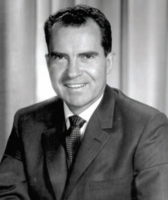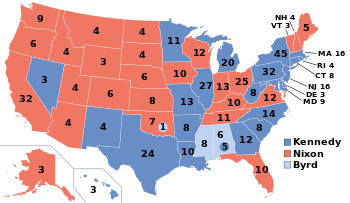United States Presidential Election, 1960
|
|
|||||||||||||||||||||||||||||
|---|---|---|---|---|---|---|---|---|---|---|---|---|---|---|---|---|---|---|---|---|---|---|---|---|---|---|---|---|---|
|
|||||||||||||||||||||||||||||
|
All 537 electoral votes of the Electoral College 269 electoral votes needed to win |
|||||||||||||||||||||||||||||
| Turnout | 62.8% |
||||||||||||||||||||||||||||
|
|||||||||||||||||||||||||||||
|
Presidential election results map. Blue denotes states won by Kennedy/Johnson, red denotes those won by Nixon/Lodge, orange denotes the electoral votes for Byrd/Thurmond by Alabama and Mississippi unpledged electors, and a vote for Byrd/Goldwater by an Oklahoma faithless elector. Numbers indicate the number of electoral votes allotted to each state.
|
|||||||||||||||||||||||||||||
|
|||||||||||||||||||||||||||||
Dwight D. Eisenhower
Republican
The United States presidential election of 1960 was the 44th quadrennial presidential election, held on Tuesday, November 8, 1960. The Republican Party nominated incumbent Vice President Richard Nixon, while the Democratic Party nominated John F. Kennedy, U.S. Senator from Massachusetts. The incumbent President, Republican Dwight D. Eisenhower, was not eligible for re-election after being elected the maximum two times allowed by the Twenty-second Amendment; he was the first President denied the choice to run for a third term by that amendment. This was the first presidential election in which voters in Alaska and Hawaii were able to participate, as both had become states in 1959.
Kennedy received 112,827 (0.17%) more votes than Nixon nationwide and although Nixon won the popular vote contest in more individual states (26 to 22), Kennedy won a 303 to 219 Electoral College victory.
The 1960 presidential election was the closest election since 1916, which can be explained by a number of factors. Kennedy benefited from the economic recession of 1957–58, which hurt the standing of the incumbent Republican Party, and he had the advantage of 17 million more registered Democrats than Republicans. Furthermore, the new votes that Kennedy, the first Roman Catholic president, gained among Catholics almost neutralized the new votes Nixon gained among Protestants. Kennedy's campaigning skills decisively outmatched Nixon's. In the end, Nixon's emphasis on his experience carried little weight, and he wasted energy by campaigning in all 50 states instead of concentrating on the swing states. Kennedy used his large, well-funded campaign organization to win the nomination, secure endorsements, and, with the aid of the last of the big-city bosses, get out the vote in the big cities. Kennedy relied on running mate Lyndon B. Johnson to hold the South, and used television effectively. There were 15 unpleged electors in the election , all 8 from Mississippi, 6 out of 11 from Alabama, and 1 out of 8 from Oklahoma for the Byrd/Thurmond ticket, and one for the Byrd/Goldwater ticket. A similar amount of faithless electors would occur 56 years later.
...
Wikipedia




